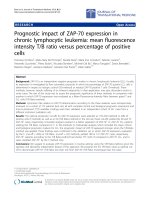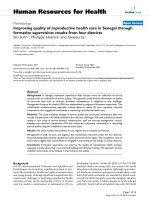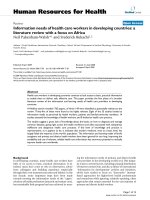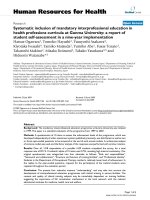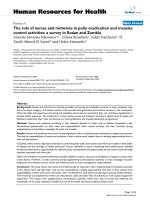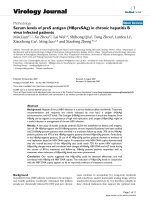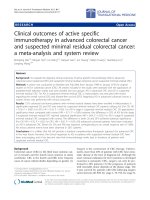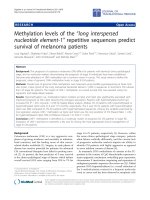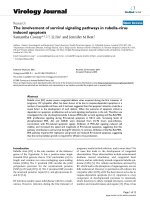Báo cáo sinh học: " Serum levels of preS antigen (HBpreSAg) in chronic hepatitis B virus infected patients" potx
Bạn đang xem bản rút gọn của tài liệu. Xem và tải ngay bản đầy đủ của tài liệu tại đây (460.2 KB, 11 trang )
BioMed Central
Page 1 of 11
(page number not for citation purposes)
Virology Journal
Open Access
Methodology
Serum levels of preS antigen (HBpreSAg) in chronic hepatitis B
virus infected patients
Min Lian
†1,2
, Xu Zhou
†2
, Lai Wei
†5
, Shihong Qiu
3
, Tong Zhou
4
, Lanfen Li
1
,
Xiaocheng Gu
1
, Ming Luo
1,3
and Xiaofeng Zheng*
1,2
Address:
1
National Laboratory of Protein Engineering and Plant Genetic Engineering, Peking University, Beijing, 100871, China,
2
Department of
Biochemistry and Molecular Biology, College of Life Sciences, Peking University, Beijing, 100871, China,
3
Department of Microbiology, University
of Alabama at Birmingham, Birmingham, Alabama, 35294, USA,
4
Department of Medicine, University of Alabama at Birmingham, Birmingham,
Alabama, 35294, USA and
5
Peking University People's Hospital, Beijing, 100014, China
Email: Min Lian - ; Xu Zhou - ; Lai Wei - ; Shihong Qiu - ;
Tong Zhou - ; Lanfen Li - ; Xiaocheng Gu - ; Ming Luo - ;
Xiaofeng Zheng* -
* Corresponding author †Equal contributors
Abstract
Background: Hepatitis B virus (HBV) infection is a serious health problem worldwide. Treatment
recommendation and response are mainly indicated by viral load, e antigen (HBeAg)
seroconversion, and ALT levels. The S antigen (HBsAg) seroconversion is much less frequent. Since
HBeAg can be negative in the presence of high viral replication, preS antigen (HBpreSAg) might be
a useful indicator in management of chronic HBV infection.
Results: A new assay of double antibody sandwich ELISA was established to detect preS antigens.
Sera of 104 HBeAg-negative and 50 HBeAg-positive chronic hepatitis B patients have been studied
and 23 HBeAg-positive patients were enrolled in a treatment follow-up study. 70% of the HBeAg-
positive patients and 47% of the HBeAg-negative patients showed HBpreSAg positive. Particularly,
in the HBeAg-negative patients, 30 out of 47 HBpreSAg positive patients showed no evidence of
viral replication based on HBV DNA copies. A comparison with HBV DNA copies demonstrated
that the overall accuracy of the HBpreSAg test could reach 72% for active HBV replication.
HBpreSAg changes were well correlated with changes of HBsAg, HBV DNA and ALT levels during
the course of IFN-α treatment and follow-up. HBeAg positive patients responded well to
treatment when reduction of HBpreSAg levels was more pronounced.
Conclusion: Our results suggested that HBpreSAg could be detected effectively, and well
correlated with HBsAg and HBV DNA copies. The reduction of HBpreSAg levels in conjunction
with the HBV DNA copies appears to be an improved predictor of treatment outcome.
Background
Hepatitis B virus (HBV) disease continues to be an impor-
tant health problem worldwide. Estimated 360 million
people are chronically infected by HBV and new chronic
cases continue to accumulate [1]. Long-term treatment
with interferon and/or nucleoside analog drugs will be
required for these patients [2-4]. It is therefore valuable to
have clinical indicators that support the optimal treat-
Published: 24 September 2007
Virology Journal 2007, 4:93 doi:10.1186/1743-422X-4-93
Received: 2 August 2007
Accepted: 24 September 2007
This article is available from: />© 2007 Lian et al; licensee BioMed Central Ltd.
This is an Open Access article distributed under the terms of the Creative Commons Attribution License ( />),
which permits unrestricted use, distribution, and reproduction in any medium, provided the original work is properly cited.
Virology Journal 2007, 4:93 />Page 2 of 11
(page number not for citation purposes)
ment of HBV infection. In addition, drug resistant
mutants and genotypic variants should also be moni-
tored.
Chronic HBV patients are classified in three states: inac-
tive HBsAg carrier-state, HBeAg-positive, and HBeAg-neg-
ative chronic hepatitis B. The inactive HBsAg carrier-state
is characterized by the presence of HBsAg and anti-HBe,
normal aminotransferase (ALT) level and low or undetec-
table level of HBV DNA in serum, indicating that HBV rep-
lication may be suppressed in the carriers. In the other two
states, HBV DNA can be detected at a much higher level in
HBeAg-positive chronic hepatitis B patients than that in
HBeAg-negative chronic hepatitis B patients. Therefore,
treatment is usually recommended for the HBeAg-positive
chronic HBV patients and the endpoint is measured typi-
cally by loss of HBeAg and low levels of HBV DNA (<10
5
copies/ml) in serum[5]. In addition, ALT level is also ref-
erenced in recommendation for antiviral therapy[6].
However, the number of HBeAg-negative, anti-HBe posi-
tive, and high DNA copies (>10
4
-10
5
copies/ml) hepatitis
B is increasing, especially in Asia and Southern Europe[7],
and many cases of these patients relapsed and caused liver
cirrhosis and hepatocellular carcinoma. Treatment regi-
ments for these cases need to be altered based on more
appropriate predictors. Demonstration of clinical efficacy
for HBeAg-negative cases with new drugs also requires
alternative markers, not only to indicate virus replication
but also to predict anti-virus response besides HBV DNA.
There are three surface structural proteins in HBV: Large
(L), middle (M), and small (S) proteins. All three proteins
contain the surface antigen (S) (226 amino acids), while
an N-terminal extension of S by 55 amino acids (desig-
nated as preS2) results in the M protein (281 amino
acids). The L protein has an additional preS1 domain that
contains 119 (genotypes A and C) or 108 (genotype D) N-
terminal amino acid residues compared to the M protein.
Full length preS is composed of preS1 and preS2 (174
amino acids for genotypes A and C, or 163 for genotype
D). Though HBsAg has been widely used as clinical mark-
ers, HBV surface antigen preS and its antibodies are not
commonly employed. However, preS is primarily present
in the DNA-containing full HBV particle as well as empty
filaments [8] and it has been shown to be associated with
virus attachment to the host cell receptor and membrane
fusion during entry[9]. Neutralizing epitopes have been
mapped in preS[10]. This special antigen also contributes
to clinical application. PreS1 and preS2 peptides have
been included in new formation of HBV vaccines to sup-
plement the widely used S-based vaccines [11-13]. In
some reports, preS1 or preS2 was included as serological
markers in prognosis [14-18]. Nonetheless, using anti-
bodies against full length preS containing both preS1 and
preS2 to detect the serum HBpreSAg has not been
reported so far. Since the functional 3D structure formed
by the full length preS is the structural basis for displaying
epitopes that are present on the active Dane viral particles,
assays using antibodies derived from a well folded preS
can result in a more accurate detection of preS antigens in
serum, which is a prerequisite for improving the assay
accuracy and exploitation of the potential significance of
HBpreSAg as a serological indicator for HBV infection.
Therefore, this study is carried out to develop a novel
assay for HBpreSAg and evaluate the potential significance
of serum HBpreSAg levels in management of HBV infec-
tion.
Results
A double antibody sandwich ELISA for measuring serum
HBpreSAg
The purified polyclonal anti-preS was examined by west-
ern blot. The result showed that the polyclonal anti-preS
can specifically identify the recombinant preS from E. coli
(data not shown).
Since the amount of spheres viral particles containing
HBsAg is much more than that of infectious Dane parti-
cles (infectious particles containing L-M-S antigens and
viral DNA) containing full length preS antigen[19], the
content of HBpreSAg in serum is more difficult to be
detected effectively than HBsAg. Meanwhile, abundance
of HBsAg could produce interference with assay of
HBpreSAg. The following experiments were carried out to
circumvent HBsAg bias.
First, a serial dilution of known amounts of recombinant
S proteins was used to plot a standard curve. The amount
of HBsAg present in serum was determined according to
the amount of recombinant S protein. The result shown in
Fig. 1B indicated that the recombinant S peptide (white
square) and HBsAg (black square) in patient serum exhib-
ited the same pattern by standardized anti-HBs antibody,
which also suggested that the recombinant S protein
indeed folded in the proper way compared to native
HBsAg. Second, known amount of recombinant S protein
was applied in anti-preS coated plates instead of serum
HBsAg to examine the bias on the measurement of
HBpreSAg (Fig. 1B). HBsAg has an extremely low binding
affinity to the polyclonal anti-preS antibody (white cir-
cle). Serum samples exhibited a sharp increase of
HBpreSAg binding to polyclonal anti-preS (black circle)
before HBsAg could bring any interference based on the
absorbance measurements using recombinant S protein.
Thus when it is below 20 µg/ml, HBsAg would not inter-
fere with the detection of HBpreSAg in the system ana-
lyzed. Polyclonal anti-preS can specifically capture
HBpreSAg and the level of serum HBpreSAg can be exam-
ined quantitatively by this assay.
Virology Journal 2007, 4:93 />Page 3 of 11
(page number not for citation purposes)
Enhanced sensitivity in detecting preS than preS1
Full lengthpreS, other than preS fragments such as preS1,
can form a well folded, functional three dimensional
structure, which is the basis for displaying epitopes in
native preS and a potential for detecting active Dane viral
particles. Therefore, antibodies prepared against full
length preS should detect well folded full length preS with
greater sensitivity than fragments of preS. In order to ver-
ify this notion, both recombinant preS1 and full length
preS were detected and compared. 0.1 ng of preS could be
easily detected, while the same amount of preS1 presented
a negative reading. The detection limit of preS1 by this
ELISA is 10 ng (Fig. 2). This result indicated that full
length preS can be detected much more effectively, which
could be interpreted that full length preS Ag could present
epitopes that were more readily recognized.
Besides, in contrast to anti-preS1 that could recognize
only L protein in serum, polyclonal anti-preS was able to
capture both L and M proteins present in patient's serum
(Fig. 3). No S protein could be detected by polyclonal
anti-preS, while it can be obviously detected by mono-
clonal anti-S as expected.
Detection of HBsAg and HBpreSAg in sera from hepatitis
B patients
HBsAg in sera from 50 HBeAg positive and 104 HBeAg
negative (anti-HBe positive) HBV patients had been quan-
titated (Fig. 4). The average value of HBsAg was higher (p
= 0.995) in HBeAg positive HBV patients (24.0 ± 19.4 µg/
ml) than that of HBeAg negative patients (1.70 ± 2.16 µg/
ml). Twenty serum samples of healthy people with nor-
mal liver functions and without any clinical marker of
HBV infection were used as controls and no HBsAg and
HBpreSAg can be detected.
Detection of HBpreSAg by ELISA was carried out using the
same serum samples. In order to ensure HBsAg levels
(A) A SDS-PAGE showing the purified recombinant preSFigure 1
(A) A SDS-PAGE showing the purified recombinant preS. (B) Binding of HBsAg to anti-HBs and to polyclonal anti-preS. An
ELISA Kit for HBsAg detection was used to detect HBsAg in the serum sample of an HBeAg positive patient (black square).
Recombinant S protein (white square) was used as control. Binding of HBsAg to polyclonal anti-preS (white circle) was
detected by adding recombinant S protein to a 96-well microplate which was coated with the polyclonal anti-preS antibody,
using the same HRP-anti-HBs in the HBsAg kit. The binding to polyclonal anti-preS by antigens in an HBeAg positive patient
serum sample is shown as (black circle). The X axis is plotted in logarithm. The absorbance at 450 nm has been subtracted by
the background.
A. B.
14.4
20.1
30.0
(kD)
MW
preS
Virology Journal 2007, 4:93 />Page 4 of 11
(page number not for citation purposes)
below 20 µg/ml, samples were diluted by 2X and 10X for
HBeAg-negative patients and HBeAg-positive cases,
respectively. All samples were tested in duplicate and the
average OD
450
was taken. In the 104 HBeAg-negative HBV
patients, 55 (53%) were HBpreSAg negative and 49 (47%)
were positive, while in the 50 HBeAg positive HBV
patients, 35 (70%) were HBpreSAg positive and 15 (30%)
were negative. The average OD
450
values of HBpreSAg in
patients from the two groups were also distinct (p = 0.87),
which was 0.62 ± 0.54 for the HBeAg positive patients and
0.35 ± 0.23 for HBeAg negative patients.
These results suggested that levels of both HBsAg and
HBpreSAg were apparently higher in HBeAg-positive
patients. Serial dilutions were performed on serum sam-
ples to compare the relative amount of HBpreSAg in both
groups. The result showed that HBpreSAg of about 50% of
the samples from HBeAg positive patients were still
detectable after 50 fold dilution. A two-fold dilution of
the serum samples from HBeAg negative patients gave a
similar result.
Correlation of Ag with HBsAg
The serum level of HBpreSAg was compared with that of
HBsAg (Fig. 4A,4C). The HBpreSAg positive portion
increased with HBsAg in both groups. However,
HBpreSAg and HBsAg presented different relationships in
the two groups. The correlation efficiency between
HBpreSAg and HBsAg is 0.713 (p < 0.01), which indicated
a liner correlation between HBsAg and HBpreSAg for
HBeAg positive patients (Fig. 4D), which is not distinctly
linear in HBeAg negative patients (Fig. 4B).
Correlation of HBpreSAg with HBeAg
For the 50 HBeAg-positive patients, the levels of HBpreAg
and HBeAg were compared and the result showed no clear
quantitative correlation (data not shown).
Correlation between HBpreSAg and serum HBV DNA
copies
Among the 50 HBeAg-positive patients detected, 43
patients showed HBV DNA positive and 35 showed
HBpreSAg positive. In twelve HBV DNA positive cases,
HBpreSAg could not be detected. In four HBpreSAg posi-
tive patients HBV DNA was below the detection limit by
PCR. For the patients showed positive in both HBpreSAg
and HBV DNA, the correlation efficiency between
HBpreSAg and HBV DNA was 0.83 (p = 0.01), suggesting
a positive correlation (Fig. 5A).
Among the 104 HBeAg-negative patients studied, the HBV
DNA copies of 99 patients have been examined. Only 28
(28%) patients showed positive HBV DNA level, of which
17 cases were HBpreSAg positive. In the remaining
patients, 41showed levels of both HBpreSAg and HBV
DNA below their detection limits. In addition, 30 of HBV
DNA negative patients were tested as HBpreSAg positive.
The portion of HBpreSAg positive increased obviously
with HBV DNA copies (Fig. 5B). Analysis of the levels of
HBpreSAg and HBsAg between HBV DNA negative and
positive patients in HBeAg-negative group also showed an
obvious difference (p-value was 0.998 for HBsAg and 0.95
Polyclonal anti-preS recognizes both L and M proteinFigure 3
Polyclonal anti-preS recognizes both L and M protein. West-
ern blot analysis was performed using polyclonal anti-preS,
and monoclonal anti-S, respectively. The bands that recog-
nized by polyclonal anti-preS correspond to the large protein
(p39/gp42) and M protein (gp33/gp36) [41]. Monoclonal anti-
S used as a positive control could detect the S protein (p24/
gp27) in addition to the L and M proteins.
L protein
M protein
S protein
anti-HBs
anti-preS
45.0kDa
35.0kDa
25.0kDa
L protein
M protein
S protein
anti-HBs
anti-preS
45.0kDa
35.0kDa
25.0kDa
Comparison of the binding ability of preS and preS1 to anti-preS by ELISA testFigure 2
Comparison of the binding ability of preS and preS1 to anti-
preS by ELISA test. Different amounts of recombinant preS1
(white square) and preS (black square) proteins (0, 0.1 ng, 1.0
ng, 10 ng and 100 ng) were added to the polyclonal anti-preS
coated plates and incubated at 37°C for 1 h, followed by
incubating with HRP conjugated monoclonal anti-His (1:1000
dilution with blocking buffer). Absorbance at 450 nm was
measured and compared. Samples were considered positive
when the OD value was over 0.15 after subtracting the back-
ground.
Virology Journal 2007, 4:93 />Page 5 of 11
(page number not for citation purposes)
for HBpreSAg). In HBV DNA negative patients, the aver-
ages of HBsAg and HBpreSAg were 1.4 ± 1.9 ug/ml and
0.29 ± 0.43 (OD450), while for the HBV DNA detectable
patients the average was 2.3 ± 2.5 µg/ml and 0.43 ± 0.53
µg/ml (OD450), indicating that HBsAg and HBpreSAg
were correlated well with HBV DNA copies.
Follow up study
Among the 23 HBeAg positive and anti-HBe negative
patients enrolled in the follow up study, 19 showed an
obvious decrease in HBpreSAg levels after IFN-α treat-
ment. None of the patients on therapy became HBsAg
negative (<0.01 µg/ml) even though their HBsAg levels
decreased (Fig. 6).
Since HBV DNA copies are generally considered as the
measure of viral loads, the response patterns of the 23
patients after IFN-α therapy were divided into three types
based on the reduction pattern of HBV DNA copies (Fig.
6, Table 1). The pattern of HBpreSAg and other serological
markers were analyzed within each group.
In type I group (Fig. 6), at the end point of the follow up
(48 weeks), HBV DNA copies dropped by about 3-logs.
The presence of HBpreSAg in serum of HBV patients and its correlation with HBsAgFigure 4
The presence of HBpreSAg in serum of HBV patients and its correlation with HBsAg. The rate of HBpreSAg presence in serum
of HBeAg-negative patients and HBeAg-positive patients were shown in (A) and (C), respectively. The white bars represent
HBpreSAg negative patients and the black bars represent HBpreSAg positive patients. Correlation of HBpreSAg levels with
HBsAg levels in serum of HBV patients were indicated in (B) for HBeAg-negative patients and (D) for HBeAg-positive patients.
The X axis indicates the serum HBsAg content and the Y axis is the absorbance of the HBpreSAg ELISA test at 450 nm after
background correction.
HBeAg-negative patients HBeAg-positive patients
Virology Journal 2007, 4:93 />Page 6 of 11
(page number not for citation purposes)
Correlation of HBpreSAg levels with HBV DNA copies in serum of HBeAg positive patients (A) and HBeAg negative (anti-HBe positive) patients (B)Figure 5
Correlation of HBpreSAg levels with HBV DNA copies in serum of HBeAg positive patients (A) and HBeAg negative (anti-HBe
positive) patients (B). (A) The X axis indicates the average HBV DNA copies at different levels and the Y axis indicates the
average absorbance of the HBpreSAg ELISA test at 450 nm corresponding to the different HBV DNA levels. (B) The detection
rate of HBV DNA was analyzed at different levels of HBpreSAg present in serum as shown in the left panel. The rates of HBV
DNA positives and negatives at each HBpreSAg level are shown at the top of each vertical bar. The white bars represent the
number of HBV DNA negative patients and the black bars represent that of HBV DNA positive patients. The detection rate of
HBpreSAg present in serum was analyzed at different levels of HBV DNA as shown in the right panel. The rates of HBpreSAg
positives and negatives at each HBV DNA level are shown at the top of each vertical bar. The white bars represent the number
of HBpreSAg negative patients and the black bars represent that of HBpreSAg positive patients.
Table 1: Average changes of HBpreSAg and HBV DNA after IFN treatment and comparisons of different HBV markers.
DNA
a
(0 wk) DNA
a
(0/24 wk) DNA
a
(0/48 wk) HBpreSAg (0 wk) HBpreSAg
(0/24 wk)
HBpreSAg
(0/48 wk)
ALT (0 wk)
Average (type I) 8.3 1.9 3.7 0.7 1.7 2.2 379
Average
(type II)
8.1 2.8 -0.4 0.9 3.3 1.9 327
Average
(type III)
8.5 0.2 0.5 0.8 1.2 1.5 423
(0/24 wk) and (0/48 wk) present the reduction of HBV DNA (logs) or HBpreSAg (folds) at 24 week and 48 week respectively compared to that of
the beginning point.
a
HBV DNA copies were presented in logarithm.
Virology Journal 2007, 4:93 />Page 7 of 11
(page number not for citation purposes)
HBeAg seroconversion was observed. The outcome for
this group after IFN-α therapy should be considered as
remission based on viral load reduction. The reduction of
the HBpreSAg levels was significant in most cases and the
levels of HBsAg decreased to a similar extent. The serum
alanine aminotransferase (ALT) levels of four of the five
patients showed an obvious decrease during IFN-α treat-
ment, and below the limit of normal at the end check
point.
In type II group (Fig. 6), based on the reduction of HBV
DNA copies, seven patients responded to the IFN-α treat-
ment well initially by the end of 24 weeks, but their viral
loads rebounded to high levels at the end point. The pat-
tern of HBpreSAg changes was similar to that of HBV DNA
copies in this group, 3.3-fold reduction on average at 24
weeks and rebounded to 1.9-fold reduction at 48 weeks
(Table 1). Four patients' anti-HBe was observed as posi-
tive during the IFN-α treatment but returned to negative
later. An obvious drop of the ALT level was observed after
IFN-α treatment, but which rebounded at the last check
point in five of the seven patients.
In type III group (Fig. 6), 11 patients did not show any sig-
nificant reduction in their viral loads during IFN-α treat-
ment. The level of HBpreSAg decreased slightly following
the IFN-α treatment. The level of HBsAg remained high
mostly and their HBeAg remained positive through the
course of treatment. Changes of ALT levels showed similar
pattern.
As shown in Table 1, the average values of viral load
reduction and HBpreSAg reduction were calculated for
each group described above. ALT levels at the beginning of
the treatment were also presented. The HBpreSAg levels
were reduced relatively more in type I and II groups than
in type III group.
Discussion
preS antigen is a potential significant serological marker
for chronic hepatitis B virus infection
Full length preS is exclusively present in the large protein
(L) and has been shown to be associated with virus attach-
ment to the host cell receptor and membrane fusion dur-
ing entry [20]. Since preS mainly exist in the DNA-
containing Dane HBV particles, detection of HBpreSAg
present in serum of HBV patients may have a clinical value
in management of HBV infection. In previous reports,
radioimmunoassays using monoclonal antibodies have
been used to detect HBsAg, preS1 or preS2 antigen in the
sera of HBV patients respectively, and these assays were
proved to have well-defined specificities[15,17,21]. How-
ever, using antibodies against full length preS including
both preS1 and preS2 to detect the serum preS has not
been reported so far.
In this study, we have established a double antibody sand-
wich ELISA system that could capture both L protein and
M protein in order to reflect the full presence of HBpreSAg
in serum of HBV patients (Fig. 3). Since functional three
dimensional structure formed from the full length of preS
is the structure basis for displaying epitopes and detecting
active Dane viral particles, using antibodies against a well
folded preS can result in a more sensitive detection of preS
antigen in serum. However, high levels of HBsAg in sera
may still introduce a bias in HBpreSAg measurements.
This problem was circumvented by diluting serum sam-
ples to ensure HBsAg below 20 µg/ml, the standard that
brought no interference into assay of HBpreSAg as dem-
onstrated by our experiment. Therefore, both sensitivity
Changes of HBpreSAg levels and other serologic markers of the three Types patients for follow up studyFigure 6
Changes of HBpreSAg levels and other serologic markers of the three Types patients for follow up study. Black square repre-
sents HBpreSAg (OD
450
), black triangle represents HBsAg (OD
450
), white circle represents ALT (IU/l) and white triangle rep-
resents HBV DNA copies (copies/ml). A typical sample for Type I-III was shown. (A) The levels of HBpreSAg, HBsAg, ALT and
HBV DNA decreased significantly without rebound in Type I patients. (B) Type II patients responded to the IFN-α treatment
well initially but rebounded at the end check point. (C) Type III patients did not respond well to the IFN-α treatment.
Virology Journal 2007, 4:93 />Page 8 of 11
(page number not for citation purposes)
and specificity of our ELISA were greatly improved in
comparison with other forms of HBpreSAg tests.
Our results indicate that HBpreSAg correlated well with
HBV DNA copies in serum. These results are consistent
with the results of Petit's[17,21] and Garbuglia's[22]. One
difference is that Petit's data showed that PCR was an ade-
quately sensitive method that could detect HBV DNA in
roughly half of the HBpreSAg negative sera, while this
ratio is 21% in our study. Of the 47 HBpreSAg positive
patients in this study, 30(64%) had no detectable HBV
DNA, which was consistent with the result of Alberti's
observation. Their results showed that preS1 and preS2
could also been detected from 7 out of 10 cases (70%)
with no evidence of viral replication, in addition to HBV
DNA positive cases[23]. Our observations and Alberti's
indicated that in the serum of HBV patients, especially for
the HBeAg-negative patients, preS is another significant
serological marker for active HBV infection in addition to
HBV DNA.
Both HBeAg and HBV DNA copies are commonly used as
clinical markers of active HBV replication, and treatments
are recommended based on diagnostic tests of these mark-
ers. Our results indicate that HBpreSAg could be another
valuable marker to supplement HBeAg (Table 2). When
HBpreSAg was compared to HBV DNA copies, the sensi-
tivity was 68% (CI, 95%, 55–78), and the specificity was
56% (CI, 95%, 45–67). This gives an overall accuracy of
62% of our HBpreSAg test. By the same comparison, the
sensitivity of the HBeAg test was 61% (CI, 95%, 48–72),
and the specificity was 91% (CI, 95%, 82–96), leading to
an overall accuracy of 77%. Similar results are obtained
when HBpreSAg is compared to HBeAg. These results sug-
gest that HBpreSAg can serve as a serological marker for
HBV replication with sensitivity slightly higher than that
of HBeAg. However, the overall accuracy of the HBpreSAg
test was dampened due to a low specificity, but not too
much off compared to the HBeAg test (62% versus 77%).
If the results of HBV DNA are reconciled with those of
HBeAg assuming that the case was truly positive if HBV
DNA and HBeAg were positive for HBpreSAg+ cases, and
the case was truly negative if HBV DNA and HBeAg were
negative for HBpreSAg- cases, the sensitivity, the specifi-
city, and the overall accuracy of the HBpreSAg test would
be, 81%, 65%, and 72%, respectively (Table 3). This
observation argues that a HBpreSAg test would be valua-
ble for detecting HBV replication in HBV patients and sug-
gests further improvements of the HBpreSAg test.
Potential application of HBpreSAg in IFN-
α
treatment
Interferon-α, as an approved treatment for hepatitis B, has
been widely used in clinical therapy[4,24-33]. According
to previous reports, the levels of serum HBV DNA, HBsAg,
HBeAg and other serological markers decrease during the
IFN-α treatment if the patient responded positively to the
IFN-α therapy. Long-term follow up studies showed that
most responders maintained their responses though very
few people had complete eradication of HBV[31]. To date,
there lacks study to follow the serum levels of full length
preS in response to IFN-α treatment.
The second objective of this study was to monitor the
change of HBpreSAg in sera of the chronic hepatitis
patients before, during and after IFN-α treatment, to
investigate the correlation of HBpreSAg with HBV DNA
copies and HBsAg. The result showed that the level of
HBpreSAg varied in different sera. The change in HBsAg
levels, HBV DNA copies, ALT levels, and HBpreSAg levels
had similar patterns in most cases, which is similar to the
result of Taliani et al's[34]. This observation is consistent
with the idea that HBpreSAg was elevated when HBV
started active replication, suggesting that preS is correlated
to other serological markers to a certain extent but has its
own merit as discussed below, and could serve as an alter-
native serological marker.
Table 2: Comparisons of serological markers for HBV replication versus HBVDNA copies in serum specimens.
HBV DNA+ HBV DNA- Sensitivity(%) Specificity(%) PPV(%) NPV (%) Overall (%)
HBpreSAg+4834 6856596662
HBpreSAg- 23 44 CI,95% 55–78 45–67
n = 149
HBV DNA+ HBV DNA- Sensitivity(%) Specificity(%) PPV(%) NPV (%) Overall (%)
HBeAg+43 7 6191867277
HBeAg- 28 71 CI,95% 48–72 82-96
n=149
HBeAg+ HBeAg- Sensitivity(%) Specificity(%) PPV(%) NPV (%) Overall (%)
HBpreSAg+3549 7053427958
HBpreSAg- 15 55 CI,95% 55-82 43-63
n=154
Virology Journal 2007, 4:93 />Page 9 of 11
(page number not for citation purposes)
Another interest was to identify any potential predictor
that could classify types of patients' response to IFN ther-
apy. According to the variation of viral loads, the 23
patients could be divided into three groups: sustained
responders, responders with rebound, and non-respond-
ers. The reduction of serum HBpreSAg levels was compar-
atively more pronounced in type I and II than in type III
(Table 1). This result indicated that patients with a signif-
icant reduction of HBpreSAg were inclined to have a better
response to IFN treatment despite high copies of HBV
DNA. More rapid HBV DNA reduction right after the treat-
ment in type II than type I also demonstrated this point.
Meanwhile, more rapid reduction of HBpreSAg in type II
than that of type I may suggest more active replication of
HBV in type II, which could explain the rebound occurred
in this type after 24 week treatment. With the relative high
level of ALT at the end point for the type II group, the
patients may require further treatment. A combination
therapy of IFN and nucleosides should be considered to
improve outcome as shown by Chan et al. [35] or the IFN
treatment should be extended.
Patients with high ALT and low HBV DNA are inclined to
respond well to interferon treatment [36-38]. In our
study, this phenomenon was also observed and its pattern
was similar to that of HBpreSAg (Table 1).
Though there is no clear reason for the prediction of IFN
treatment based on ALT, HBV DNA or HBpreSAg, our
study revealed a potential application of HBpreSAg in pre-
diction of IFN treatment. Moreover, this experiment
revealed that the reduction rate of HBpreSAg appeared to
be a predictor for the outcome of interferon treatment and
perhaps HBpreSAg was involved in interplays between
interferon activities and HBV virus infection, which, how-
ever, required further investigation by examining more
patients.
Conclusion
The establishment of the new ELISA method enables us to
capture both the L and M proteins, and properly reflect the
full presence of HBpreSAg in serum of HBV patients.
Applying this assay to serum samples from HBeAg-nega-
tive patients, 30 out of 47 HBpreSAg positive patients
showed no evidence of viral replication. HBpreSAg can
serve as a serological marker for HBV replication with sen-
sitivity slightly higher than that of HBeAg. The follow up
study showed that HBpreSAg levels in sera of the chronic
hepatitis patients examined during and after IFN-α treat-
ment changed in similar patterns, in most cases, with
HBsAg levels, HBV DNA copies and ALT levels. More
importantly, reduction of HBpreSAg levels indicated a
good response to IFN-α treatment and vice versa, suggest-
ing the level of HBpreSAg in conjunction with the HBV
DNA copies might be a potential predictor of treatment
efficacy. Limited by the number of patients, a reliable sta-
tistical analysis could not be conducted among the three
types of patients. However, the potential of HBpreSAg and
HBV DNA in predicting IFN-α treatment is well presented
in this study. Detection of full presence of HBpreSAg in
this study provided an alternative serological marker and
will allow for an improved evaluation of chronic HBV
infection.
Methods
Sera
The patients with clinical evidence of hepatitis B from
People's Hospital of Peking University were chosen in this
study. Sera from 104 HBeAg-negative (anti-HBe positive)
chronic hepatitis B and 50 HBeAg-positive outpatients
with identified age and gender have been tested. Sera of
20 healthy people without any clinical markers of HBV
infection and with normal liver functions were used as
negative control. 23 inpatients tested HBeAg positive and
anti-HBe negative were enrolled in a 48 week follow-up
study with 3 MU IFN-α thrice weekly applied in the begin-
ning 24 weeks. Their serum specimens were collected at 5
check points at twelve week intervals, and their HBpreSAg,
HBV-DNA, HBsAg, HBeAg and ALT were analyzed as well.
All samples were collected according to the guidelines of
the ethical committee in Peking University People's hos-
pital with patients' written consent.
Preparation and examination of anti-preS polyclonal
antibody
A polyclonal antiserum to preS was prepared by immuniz-
ing rabbits with purified full length preS protein contain-
ing both preS1 and preS2 (≥95% purity, Fig. 1A) of
subtype adw (Accession No. P03142) following our previ-
ous procedure[39]. Western blot was carried out to test
both the specificity of polyclonal anti-preS using recom-
binant preS protein and the ability of polyclonal anti-preS
in detecting both preS1 and preS2 regions in patient's
serum.
Table 3: Comparison of the HBpreSAg test versus HBV DNA copies in serum specimens, with reconciliation by HBeAg results.
HBV+ (DNA+ reconciled by HBeAg+) HBV- (DNA- reconciled by HBeAg-) Sensitivity(%) Specificity(%) PPV(%) NPV (%) Overall (%)
HBpreSAg+ 52 30 81 65 63 82 72
HBpreSAg- 12 55 CI,95% 72-89 58-70
n=149
Virology Journal 2007, 4:93 />Page 10 of 11
(page number not for citation purposes)
Detection of HBpreSAg in serum by a double antibody
sandwich ELISA
preS antigen was determined in serial serum samples
using a double antibody sandwich ELISA with polyclonal
anti-preS generated as described above and monoclonal
anti-HBs (raised by immunizing mice with purified virus
particles) as follows. Four serial dilutions of sera (1:2,
1:10, 1:50 and 1:250 diluted with blocking buffer in PBS,
pH7.4) were added to anti-preS coated wells and incu-
bated at 37°C for 1 h. The wells were then incubated with
HRP conjugated monoclonal anti-S (1:1000 dilution with
blocking buffer containing 3% BSA, 20% goat serum in
PBS). Absorbance at 450 nm was measured by microplate
reader (Prolong, China). Samples were considered posi-
tive when the OD value was over 0.15 after subtracting the
background.
Detection of HBsAg in serum of chronic HBV patients
HBsAg was determined in the same serum samples by
using an ELISA kit (Wan Tai Diagnostics Corp, Beijing,
China), following the manufacturer's instructions. Four
serial dilutions of sera (1:20, 1:100, 1:500 and 1:2500
diluted with blocking buffer in PBS, pH7.4) were applied
and absorbance at 450 nm was measured. In order to
quantify HBsAg in sera, known amount of recombinant S
protein (Fudan-Yueda Bio-Tech Co. China) was serially
diluted to plot a standard curve by using the same ELISA
kit.
Detection of HBeAg in serum of chronic HBV patients
Serum HBeAg measurements were performed based on an
immunoenzymometric assay (IEMA) using HBeAg/Ab
IEMA Well (RADIM S.pA., Italy) according to the manu-
facturer's instruction.
Quantification of HBV DNA in serum by PCR
Quantification of serum HBV DNA was performed by the
LightCycler PCR system (Roche, Basel, Switzerland) using
fluorescent quantitative PCR kits (PG Biotech, Shenzhen,
China). The sensitivity of the assay was 300 copies/ml of
HBV DNA.
Serum alanine aminotransferase (ALT) measurements
Serum ALT measurements were performed with the Reflo-
tron system (Fa. Boehringer Mannheim). [40] The upper
normal range of ALT was 40 IU/l and this threshold was
given by the manufacture.
Abbreviations
HBV, hepatitis B virus; HBsAg, hepatitis B surface antigen;
HBpreSAg, hepatitis B pre-surface antigen; HBeAg, hepati-
tis B e antigen, anti-HBs, antibody to HBsAg; anti-preS,
antibody to hepatitis B preS antigen; IFN-α, interferon-
alpha; ALT, alanine aminotransferase.
Competing interests
The author(s) declare that they have no competing inter-
ests.
Authors' contributions
ML – carried out protein purification, performed ELISA
analysis and assisted with manuscript preparation. XZ –
prepared polyclonal anti-preS, interpreted the data, and
assisted with manuscript preparation. LW – provided
patients sera, measured HBV DNA and ALT. SQ – con-
structed the protein expression vector. TZ – assisted in
study design and provided monoclonal anti-HBs anti-
body. LL – assisted in ELISA analysis. XG – assisted in
study design and helped edit the manuscript. ML –
designed and oversaw the study, interpreted the data and
wrote the manuscript. XZ -designed and oversaw the
study, interpreted the data and wrote the manuscript. All
authors read and approved the final manuscript.
Acknowledgements
This work was supported by grants from International Centre for Genetic
Engineering and Biotechnology (ICGEB) (Project No. CRP/CHN05-01), the
National Science Foundation of China (No. 30328006), and Beijing Munici-
pal Science & Technology Commission (H030230280410).
References
1. EASL International Consensus Conference on Hepatitis B.
13-14 September, 2002: Geneva, Switzerland. Consensus
statement (short version). J Hepatol 2003, 38(4):533-540.
2. Guan R: Treatment of chronic hepatitis B infection using
interferon. Med J Malaysia 2005, 60 Suppl B:28-33.
3. Santantonio T, Mazzola M, Iacovazzi T, Miglietta A, Guastadisegni A,
Pastore G: Long-term follow-up of patients with anti-HBe/
HBV DNA-positive chronic hepatitis B treated for 12
months with lamivudine. J Hepatol 2000, 32(2):300-306.
4. Yuce A, Kocak N, Ozen H, Gurakan F: Prolonged interferon
alpha treatment in children with chronic hepatitis B. Ann Trop
Paediatr 2001, 21(1):77-80.
5. Hoofnagle JH: Therapy of viral hepatitis. Digestion 1998,
59(5):563-578.
6. Tillmann HL: Antiviral therapy and resistance with hepatitis B
virus infection. World J Gastroenterol 2007, 13(1):125-140.
7. Bonino F, Brunetto MR: Chronic hepatitis B e antigen (HBeAg)
negative, anti-HBe positive hepatitis B: an overview. J Hepatol
2003, 39 Suppl 1:S160-3.
8. Herrmann G, Gregel C, Hubner K: [Pathogenetic role of HBV in
liver cell carcinoma of Western European patients]. Verh
Dtsch Ges Pathol 1995, 79:126-131.
9. Urban S, Kruse C, Multhaup G: A soluble form of the avian hep-
atitis B virus receptor. Biochemical characterization and
functional analysis of the receptor ligand complex. J Biol Chem
1999, 274(9):5707-5715.
10. Neurath AR, Kent SB, Parker K, Prince AM, Strick N, Brotman B,
Sproul P: Antibodies to a synthetic peptide from the preS 120-
145 region of the hepatitis B virus envelope are virus neutral-
izing. Vaccine 1986, 4(1):35-37.
11. Shouval D, Ilan Y, Adler R, Deepen R, Panet A, Even-Chen Z, Gorecki
M, Gerlich WH: Improved immunogenicity in mice of a mam-
malian cell-derived recombinant hepatitis B vaccine contain-
ing pre-S1 and pre-S2 antigens as compared with
conventional yeast-derived vaccines. Vaccine 1994,
12(15):1453-1459.
12. Shouval D: Hepatitis B vaccines. J Hepatol 2003, 39 Suppl
1:S70-6.
13. Madalinski K, Sylvan SP, Hellstrom U, Mikolajewicz J, Dzierzanowska-
Fangrat K: Presence of anti-preS1, anti-preS2, and anti-HBs
Publish with BioMed Central and every
scientist can read your work free of charge
"BioMed Central will be the most significant development for
disseminating the results of biomedical research in our lifetime."
Sir Paul Nurse, Cancer Research UK
Your research papers will be:
available free of charge to the entire biomedical community
peer reviewed and published immediately upon acceptance
cited in PubMed and archived on PubMed Central
yours — you keep the copyright
Submit your manuscript here:
/>BioMedcentral
Virology Journal 2007, 4:93 />Page 11 of 11
(page number not for citation purposes)
antibodies in newborns immunized with Bio-Hep-B vaccine.
Med Sci Monit 2004, 10(1):PI10-7.
14. Petit MA, Capel F, Gerken G, Dubanchet S, Brechot C, Trepo C: Sig-
nificance and relevance of serum preS1 antigen detection in
wild-type and variant hepatitis B virus (HBV) infections. Arch
Virol Suppl 1993, 8:179-187.
15. Petit MA, Buffello-Le Guillou D, Roche B, Dussaix E, Duclos-Vallee JC,
Feray C, Samuel D: Residual hepatitis B virus particles in liver
transplant recipients receiving lamivudine: PCR quantitation
of HBV DNA and ELISA of preS1 antigen. J Med Virol 2001,
65(3):493-504.
16. Kobayashi M, Suzuki F, Arase Y, Akuta N, Suzuki Y, Hosaka T, Saitoh
S, Kobayashi M, Tsubota A, Someya T, Ikeda K, Matsuda M, Sato J,
Kumada H: Infection with hepatitis B virus genotype A in
Tokyo, Japan during 1976 through 2001. J Gastroenterol 2004,
39(9):844-850.
17. Le Guillou DB, Duclos-Vallee JC, Eberle F, Capel F, Petit MA: Evalu-
ation of an enzyme-linked immunosorbent assay for detec-
tion and quantification of hepatitis B virus PreS1 envelope
antigen in serum samples: comparison with two commercial
assays for monitoring hepatitis B virus DNA. J Viral Hepat
2000, 7(5):387-392.
18. Mi Z, Feng F, Zhang X, Lian Z, Wang H, Tong Y: The clinical and
epidemiological significance of serum PreS1/anti-PreS1 in
HBV infection. Chin Med J (Engl) 1999, 112(4):321-324.
19. Gerlich W, Gauhl C, May G: [Separation of morphological types
of hepatitis B-antigen (author's transl)]. Zentralbl Bakteriol [Orig
A] 1975, 232(2-3):189-198.
20. Urban S, Schwarz C, Marx UC, Zentgraf H, Schaller H, Multhaup G:
Receptor recognition by a hepatitis B virus reveals a novel
mode of high affinity virus-receptor interaction. Embo J 2000,
19(6):1217-1227.
21. Petit MA, Capel F, Zoulim F, Dubanchet S, Chemin I, Penna A, Ferrari
C, Trepo C: PreS antigen expression and anti-preS response
in hepatitis B virus infections: relationship to serum HBV-
DNA, intrahepatic HBcAg, liver damage and specific T-cell
response. Arch Virol Suppl 1992, 4:105-112.
22. Garbuglia AR, Manzin A, Budkowska A, Taliani G, Delfini C, Carloni
G: PCR analysis of HBV infected sera: relationship between
expression of pre-S antigens and viral replication. Arch Virol
Suppl 1992, 4:113-115.
23. Fraiese A, Pontisso P, Cavalletto D, Fattovich G, Alberti A: Expres-
sion of preS1 and preS2 in the liver of chronic hepatitis B
virus carriers. J Hepatol 1988, 7(2):157-163.
24. Fattovich G, Brollo L, Boscaro S, Pontisso P, Giustina G, Criscuolo D,
Maladorno D, Alberti A, Realdi G, Ruol A: Long-term effect of low
dose recombinant interferon therapy in patients with
chronic hepatitis B. J Hepatol 1989, 9(3):331-337.
25. Braken JB, Koopmans PP, Van Munster IP, Gribnau FW: Current
status of interferon alpha in the treatment of chronic hepa-
titis B. Pharm Weekbl Sci 1992, 14(4):167-173.
26. Teran JC, Mullen KD, Hoofnagle JH, McCullough AJ: Decrease in
serum levels of markers of hepatic connective tissue turno-
ver during and after treatment of chronic hepatitis B with
interferon-alpha. Hepatology 1994, 19(4):849-856.
27. Zarski JP, Causse X, Cohard M, Cougnard J, Trepo C: A rand-
omized, controlled trial of interferon alfa-2b alone and with
simultaneous prednisone for the treatment of chronic hepa-
titis B. French Multicenter Group. J Hepatol 1994,
20(6):735-741.
28. Brunetto MR, Oliveri F, Colombatto P, Capalbo M, Barbera C, Bonino
F: Treatment of chronic anti-HBe-positive hepatitis B with
interferon-alpha. J Hepatol 1995, 22(1 Suppl):42-44.
29. Brunetto MR, Bonino F: Treatment of chronic hepatitis B: from
research to clinical practice via the consensus conferences.
Curr Pharm Des 2004, 10(17):2063-2075.
30. Cotonat T, Quiroga JA, Lopez-Alcorocho JM, Clouet R, Pardo M,
Manzarbeitia F, Carreno V: Pilot study of combination therapy
with ribavirin and interferon alfa for the retreatment of
chronic hepatitis B e antibody-positive patients. Hepatology
2000, 31(2):502-506.
31. Guan R: Interferon monotherapy in chronic hepatitis B. J Gas-
troenterol Hepatol 2000, 15 Suppl:E34-40.
32. Yuen MF, Hui CK, Cheng CC, Wu CH, Lai YP, Lai CL: Long-term
follow-up of interferon alfa treatment in Chinese patients
with chronic hepatitis B infection: The effect on hepatitis B e
antigen seroconversion and the development of cirrhosis-
related complications. Hepatology 2001, 34(1):139-145.
33. Craxi A, Cooksley WG: Pegylated interferons for chronic hep-
atitis B. Antiviral Res 2003, 60(2):87-89.
34. Taliani G, Rapicetta M, Francisci D, Xiang J, Sarrecchia B, De Bac C,
Stagni G: Correlation of preS antigens and clinical status dur-
ing chronic hepatitis B virus infection. Med Microbiol Immunol
(Berl) 1991, 180(5):239-248.
35. Chan HL, Hui AY, Wong VW, Chim AM, Wong ML, Sung JJ: Long-
term follow-up of peginterferon and lamivudine combina-
tion treatment in HBeAg-positive chronic hepatitis B. Hepa-
tology 2005, 41(6):1357-1364.
36. Lau DT, Comanor L, Minor JM, Everhart JE, Wuestehube LJ, Hoofna-
gle JH: Statistical models for predicting a beneficial response
to interferon-alpha in patients with chronic hepatitis B. J Viral
Hepat 1998, 5(2):105-114.
37. Lok AS, McMahon BJ: [AASLD Practice Guidelines. Chronic
hepatitis B: update of therapeutic guidelines]. Rom J Gastroen-
terol 2004, 13(2):150-154.
38. McMahon BJ: Selecting appropriate management strategies
for chronic hepatitis B: who to treat. Am J Gastroenterol 2006,
101(1 Suppl):S7-S12.
39. Ren H, Wang L, Bennett M, Liang Y, Zheng X, Lu F, Li L, Nan J, Luo
M, Eriksson S, Zhang C, Su XD: The crystal structure of human
adenylate kinase 6: An adenylate kinase localized to the cell
nucleus. Proc Natl Acad Sci U S A 2005, 102(2):303-308.
40. Grunenberg R, Kruger J: [Diagnosis of the presence of SGPT in
blood donors]. Beitr Infusionsther 1992, 30:73-74.
41. Heermann KH, Goldmann U, Schwartz W, Seyffarth T, Baumgarten
H, Gerlich WH: Large surface proteins of hepatitis B virus con-
taining the pre-s sequence. J Virol 1984, 52(2):396-402.
